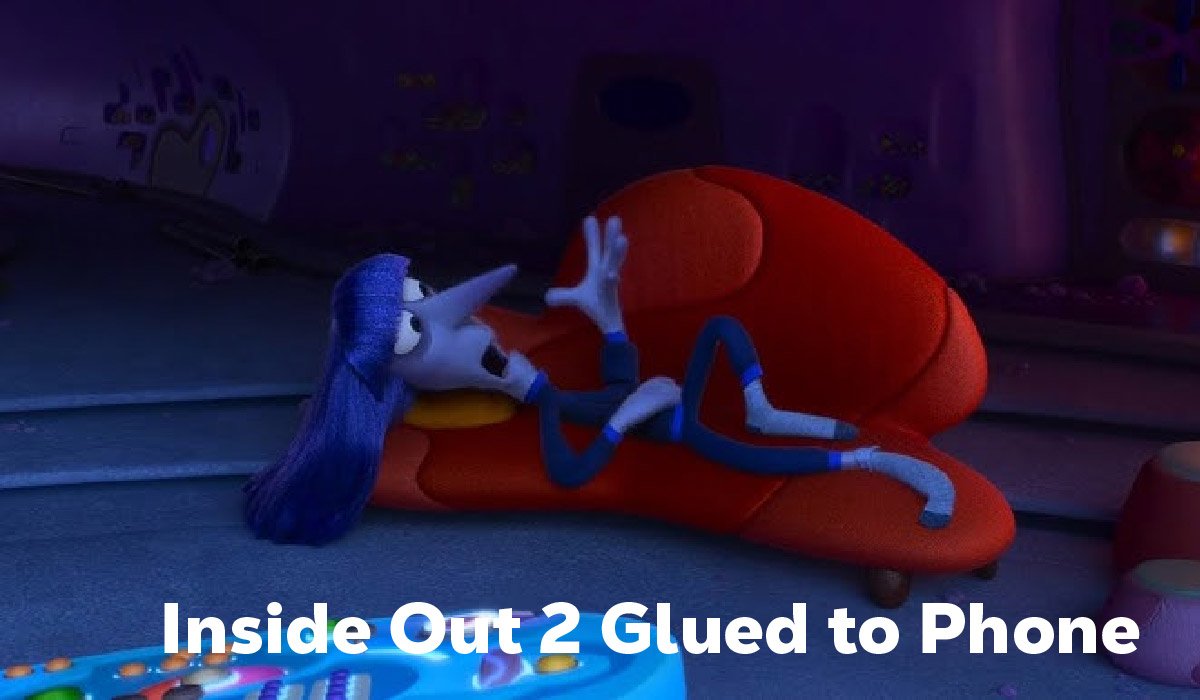Blog
Inside Out 2 Glued to Phone: Powerful Truth About Teen Screen Addiction

In today’s fast-paced digital world, smartphones are more than just devices—they’ve become lifelines, companions, and sometimes even emotional crutches. From waking up to going to bed, many of us are glued to our screens without realizing the emotional consequences. Pixar, known for its heartfelt storytelling, has stepped into this digital dilemma with its latest film, Inside Out 2 Glued to Phone.
This sequel dares to explore the emotional turbulence caused by excessive screen time, especially in teens who are trying to find their place in an increasingly connected world. By portraying technology addiction not just as a habit but as an emotional imbalance, the film taps into a struggle that both children and adults recognize all too well. The metaphor of being “glued to your phone” isn’t just literal in the movie—it’s emotional, symbolic, and painfully relatable. In a world filled with pings, likes, and notifications, Inside Out 2 shows what really happens inside the mind when technology starts taking over.
Recap – What Made the First Inside Out So Powerful
Inside Out (2015) revolutionized how we talk about feelings. Set inside the mind of an 11-year-old girl named Riley, the movie introduced audiences to five core emotions—Joy, Sadness, Fear, Anger, and Disgust—each portrayed as a character helping Riley navigate her experiences. The brilliance of the first film was how it made abstract concepts like emotional regulation and mental health understandable, even for young audiences.
It reminded us that all emotions have a purpose, and feeling sad doesn’t mean something is wrong—it means something matters. Viewers around the world saw themselves in Riley’s struggles with moving to a new city, adapting to change, and dealing with growing pains. It wasn’t just a kid’s movie; it was a psychological mirror for adults as well. The emotional depth, wrapped in Pixar’s trademark humor and imagination, made Inside Out a modern classic and sparked worldwide conversations about mental wellness.
Announcement of Inside Out 2 – A Sequel for the Digital Age
When Pixar announced Inside Out 2, fans were ecstatic. The anticipation was high, but what made this sequel stand out was its bold premise: exploring the emotional effects of growing up in the age of smartphones and social media. Unlike the original, which focused on childhood changes, Inside Out 2 Glued to Phone dives headfirst into teenage life—complete with digital distractions, online pressures, and the constant buzz of technology.
Riley is now a high school student, and her challenges have evolved. She’s navigating friendships, identity, and self-worth in a world where your online persona often matters more than your real-life presence. The central conflict of the film isn’t just between emotions; it’s between emotional presence and digital detachment. The introduction of smartphones as a disruptive force inside Riley’s mind provides a fresh, relevant layer to the emotional storytelling that Pixar does best.
Meet the New Emotions – Expanding Riley’s Inner World
In Inside Out 2, the emotional team inside Riley’s mind gets a major update. While Joy, Sadness, Fear, Anger, and Disgust still play their essential roles, they’re now joined by new, more complex emotions that reflect the complications of adolescence. Anxiety constantly checks notifications and worries about Riley’s social standing. Envy watches filtered photos of others and whispers comparisons. Embarrassment hides when Riley posts something awkward online.
Curiosity pushes her to explore every app and social trend, sometimes at the expense of her real-world focus. These newcomers don’t just add variety—they illustrate how teen emotions are layered, confusing, and often triggered by online behavior. In a subplot involving Max and Lily, two teens who represent alternate emotional paths Riley could take, we see how different emotional profiles respond to technology. Max is driven by approval, Lily by escape. Together, they show how different personalities can still end up “glued to phone” in their own unique emotional spirals.
Plot Overview – What Happens in Inside Out 2: Glued to Phone
The film begins with Riley entering a new phase of life—teenhood. She’s joined a new school, made new friends, and been gifted her first smartphone. At first, the phone seems harmless—helpful, even. But soon, things spiral. Riley starts checking notifications obsessively, withdrawing from face-to-face interactions, and prioritizing online approval over real-life joys. Inside her mind, the control center becomes chaotic. Joy tries to steer Riley back toward balance, but Anxiety hijacks the controls during social media posts. Envy obsessively watches her friend group’s online activities. Embarrassment constantly deletes posts out of fear of judgment.
The “glued to phone” moment is visualized brilliantly: Riley’s body is frozen in place, face bathed in screen light, as her emotions scramble inside to regain control. This powerful metaphor plays out in both hilarious and heartbreaking ways, culminating in a scene where Riley realizes she’s missing out on real moments while trying to capture the perfect ones for her feed.
Symbolism of the “Glued to Phone” Scene
The most iconic moment in the film—Riley literally glued to her phone—is rich in symbolism. It represents how teens today often feel powerless in the face of technology’s pull. The scene shows Riley unable to respond to her parents calling her name or engage with her friends in real time, as her mind is fully absorbed in the digital world. Inside her brain, the emotions are overwhelmed with flashing icons, alerts, and social pressure—all set against a backdrop of noise and mental fog. It’s a haunting yet truthful depiction of digital dependency.
The scene also serves as a critique of the validation loop driven by likes, shares, and reactions. FOMO, comparison, and overstimulation aren’t just side effects—they become emotional triggers that disrupt balance and steal joy. The moment becomes a wake-up call not just for Riley, but for the audience, too.
Emotional Consequences of Screen Addiction – What Pixar Gets Right
Pixar doesn’t treat screen addiction as a surface-level issue—it dives into the emotional consequences with nuance. Joy, once the dominant emotion, finds herself overwhelmed and sidelined by louder voices. Sadness feels increasingly neglected, buried under curated online positivity. Anger lashes out when social interactions don’t match online expectations. Envy feeds off filtered realities, constantly lowering Riley’s self-esteem.
Anxiety becomes the de facto leader, trying to control every social move to avoid embarrassment. These shifts inside Riley’s emotional world mirror the real-life psychological effects of digital addiction. Teen studies repeatedly link excessive phone use to increased anxiety, sleep disruption, low self-worth, and depression. Rather than simply citing these issues, Inside Out 2 Glued to Phone personifies them, allowing viewers to experience the tension and imbalance from within Riley’s mind—a powerful storytelling method that makes statistics feel personal.
Social Media and Teen Identity – A Battle Inside the Mind
Identity formation is one of the most delicate tasks during adolescence, and Inside Out 2 masterfully shows how smartphones complicate that process. Riley, like many teens, begins to tie her self-worth to her online image. What begins as fun quickly becomes a source of pressure: choosing the right filter, getting enough likes, avoiding embarrassing moments, and fitting in digitally. Inside her mind, her emotions react to every online post and comment.
Joy wants Riley to express herself, but Envy and Anxiety constantly pull her back into self-comparison. This leads to a distorted sense of identity where Riley no longer knows who she is without her phone. The film challenges viewers to consider how online personas influence our real selves. Is Riley really happy, or just performing happiness for an audience? That question lingers long after the scene ends.
Technology’s Impact on Relationships – A Real-World Reflection
Max and Lily, supporting characters in the film, help drive home the point that phones can bring people together—but they can also push them apart. The two teens, once close friends, begin to grow emotionally distant even while constantly messaging each other. Their in-person interactions are shallow, dominated by quick glances at their phones and robotic responses. The film shows them sitting at a lunch table together, but each is engrossed in their own device, missing each other completely.
The emotional cost is clear—loneliness despite digital connection. This subplot reflects what countless families and friends experience today: the illusion of connection through screens while real bonds weaken. Silent dinners, background noise, and distracted affection aren’t fictional—they’re daily realities in many households. Inside Out 2 Glued to Phone holds up a mirror and gently nudges us to notice how often we trade quality time for scrolling.
Humor Meets Reality – Why This Movie Resonates
What makes Inside Out 2 Glued to Phone truly work is its perfect balance of humor and depth. Yes, the scenes of Riley tripping over things while texting, or Joy getting lost in a never-ending meme loop, are hilarious. But beneath every laugh lies a sobering truth. Pixar doesn’t preach—it entertains first, then delivers its message.
The generational divide is also cleverly portrayed, with Riley’s parents struggling to understand her obsession while reminiscing about their own simpler times. These moments create shared laughter across age groups while fostering mutual understanding. The film doesn’t blame kids for being glued to their phones. Instead, it shows that everyone—teens, adults, even animated emotions—is struggling to stay emotionally grounded in a wired world.
Reactions from Parents, Teens, and Educators
Since its release, Inside Out 2 has sparked praise from parents, teens, and educators alike. Parents have expressed gratitude for a film that captures their kids’ struggles in such an emotionally intelligent way. Teens have found comfort in seeing their own experiences represented without judgment. Educators are already using scenes from the movie in social-emotional learning (SEL) programs to teach students about emotional regulation and digital mindfulness. By turning screen addiction into a relatable narrative, Inside Out 2 Glued to Phone has opened the door for healthier conversations at home and in classrooms. It has made invisible battles visible, and that visibility is the first step toward change.
How Inside Out 2 Promotes Digital Wellness
One of the film’s strongest qualities is its balanced view of technology. It doesn’t label phones as “bad”—instead, it highlights the importance of intentional usage. Riley’s turning point doesn’t come from deleting all her apps or throwing away her phone. It comes from awareness. She realizes that she has the power to decide how she uses her device. Joy and the other emotions gradually regain control, guiding Riley back to real-world connections and joy beyond the screen. This approach is refreshing. Instead of fear-mongering, the movie promotes digital wellness—healthy habits, emotional awareness, and tech/life balance. It’s not about unplugging forever; it’s about reconnecting with what really matters.
Life Lessons from Max and Lily – When Friendship Meets Reality
The emotional arc of Max and Lily serves as a quiet but powerful subplot. Their relationship deteriorates not because of conflict but because of distraction. In a key scene, they watch a childhood video of themselves laughing, running, and playing—without any devices in sight. This moment shakes them, prompting them to put down their phones and reconnect face-to-face. It’s a silent but transformative turning point that says more than words ever could. Their journey echoes the silent longing many teens feel today—the desire for real connection amidst a sea of digital noise. Their decision to choose presence over performance becomes a profound message: sometimes joy is just a conversation away, if you’re willing to look up.
Tips for Managing Screen Time Inspired by Inside Out 2
The film doesn’t just tell a story—it leaves viewers with practical inspiration. Here are some simple yet powerful takeaways:
-
📵 Set screen-free zones like at dinner or before bed.
-
⏳ Use built-in app timers to limit mindless scrolling.
-
💬 Talk openly as a family about how phones make you feel.
-
🤝 Replace passive screen time with active shared experiences.
-
🔄 Try “Digital Detox Sundays” where the family unplugs together.
These habits, though small, can create big shifts in emotional balance, especially for teens still forming their identities.
Inside Out 2 and the Bigger Picture – Why It Matters in 2025
In a world saturated by technology, Inside Out 2 Glued to Phone isn’t just a sequel—it’s a cultural landmark. It reflects the realities of emotional life in 2025, a time when mental health and digital dependency are at the forefront of public discourse. Pixar once again proves that animation isn’t just for kids—it’s a medium for all ages to reflect, grow, and heal. By personifying emotional complexity in the age of smartphones, the film starts a much-needed dialogue about awareness, connection, and choice.
Conclusion
Inside Out 2 Glued to Phone is more than a film—it’s a mirror, a guide, and a gentle wake-up call. It doesn’t demonize technology, but it does challenge us to look at how we use it. Riley’s journey is a reminder that while screens may offer comfort and connection, real joy comes from presence, purpose, and people. As we put down our phones, we may just find that the emotions waiting for us offline are the ones that truly matter.
FAQs About inside out 2 glued to phone
1. What is Inside Out 2 Glued to Phone about?
Inside Out 2 Glued to Phone is a Pixar movie that explores how teenagers deal with technology addiction and emotional changes. It shows Riley, a teenage girl, struggling with her phone use and how it affects her emotions and relationships.
2. Why is Riley glued to her phone in Inside Out 2?
In the movie, Riley becomes emotionally attached to her smartphone because of social media, notifications, and pressure to fit in. Her emotions inside her mind—like Anxiety and Envy—react to online likes and posts, making it hard for her to focus on real life.
3. What emotions are introduced in Inside Out 2?
Inside Out 2 introduces new emotions such as Anxiety, Envy, Embarrassment, and Curiosity. These new emotions join Joy, Sadness, Anger, Fear, and Disgust to help Riley manage her teenage challenges in a tech-heavy world.
4. What is the message of Inside Out 2 Glued to Phone?
The movie’s main message is about finding balance between screen time and real life. It teaches that phones aren’t bad, but too much use can affect emotions, mental health, and relationships. The key is to be aware and make time for real-world experiences.
5. How does Inside Out 2 help with screen addiction awareness?
Inside Out 2 helps raise awareness by showing how phones affect Riley’s emotional well-being. It uses humor and storytelling to explain screen addiction in a relatable way, encouraging viewers—especially teens and families—to reflect on their phone habits.
For More Information Visit Coopermagazine
-

 Celebrity1 year ago
Celebrity1 year agoWho Is Jennifer Rauchet?: All You Need To Know About Pete Hegseth’s Wife
-

 Celebrity1 year ago
Celebrity1 year agoWho Is Mindy Jennings?: All You Need To Know About Ken Jennings Wife
-

 Celebrity1 year ago
Celebrity1 year agoWho Is Enrica Cenzatti?: The Untold Story of Andrea Bocelli’s Ex-Wife
-

 Celebrity1 year ago
Celebrity1 year agoWho Is Klarissa Munz: The Untold Story of Freddie Highmore’s Wife
















